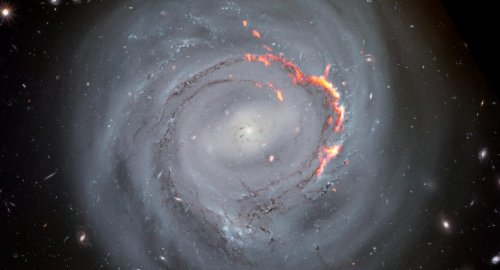
Astronomers Catch a Cosmic Boomerang in Action for the First Time

- 23-08-2021, 18:16
INA – Sources
For the first time, astronomers have observed a cosmic boomerang effect — streams of heavy, molecular gas that are stripped away from a distant galaxy only to circle back and return later.
Astronomers at Yale and Arizona State University led the research team that made the discovery, which had been theorized in simulations but not observed in detail. Their findings are published in The Astrophysical Journal.
The observation offers new insights into the life cycle of galaxies and the structural formations within galaxies, as traced by molecular gas. In particular, the research focuses on a process called ram pressure stripping, in which gas from galaxy clusters acts like a wind that strips away the star-making material inside a galaxy — hastening its demise.
“Astronomers are interested in studying how galaxies grow, live, and die,” said lead author William Cramer, who began the research as a Yale graduate student and is now a postdoctoral research scholar at Arizona State.
“Effects like ram pressure that can speed up the normal galaxy lifecycle are very important to understand for this reason. Furthermore, the molecular gas in galaxies is the birthplace of new stars, and therefore studying the effect of ram pressure on it is of paramount importance.”
For the study, the researchers used the Atacama Large Millimeter Array (ALMA) radio telescope, located in northern Chile, to create a high-resolution map of dense molecular gas in the galaxy NGC 4921 as it experiences ram pressure stripping. The map shows unusual structures that form in the ram pressure “wind” — long filaments of heavy gas connected to newly-forming stars. This dense, heavy gas is thought to be more resistant to ram pressure stripping, perhaps due to magnetic fields holding it more firmly in place.
“When an external force like ram pressure disturbs a galaxy, it offers an opportunity to learn about the internal forces that operate in galaxies,” said co-author Jeffrey Kenney, a professor of astronomy in Yale’s Faculty of Arts and Sciences. “The unusual filaments would not form without magnetic fields, so we also learn about the importance of magnetic fields in galaxies from this ram pressure interaction.”
The ALMA data clearly show filaments of molecular gas connected to galaxy NGC 4921 — the filaments are, indeed, resisting. But then the researchers saw something else: Some of the previously-stripped gas comes back.
“Instead of being thrown out never to return, some of this gas is moving like a boomerang, being ejected but then circling and falling back to its source,” Cramer said. If this gas is recaptured into the galaxy, it can form new stars.
The boomerang effect is significant for several reasons, according to the researchers. It provides hard evidence about the evolution of galaxies; it confirms a long-held theory about galaxy development; and it aids astronomers trying to predict the birthrate of new stars.
“The interstellar medium of galaxies is complex, with many variables that are hard to model,” Cramer said. “This observation is important because it shows that fallback of gas can be detected and allows us to search more broadly to help characterize it.”
First joint picture of Greenland Ice Sheet melting, ESA
- Multimedia
- 09:28
US Central Command: We killed ISIS terrorist leader Abu Yusuf in Syria
- International
- 24/12/20
Liverpool compete with Real Madrid to sign Olympique Lyonnais star
- Security
- 24/12/19
ISC, ADX discuss Strengthening Economic Ties
- Economy
- 24/12/16
Iraq assumes presidency of Arab Investment Company’s Executive Board
- Economy
- 24/12/17












